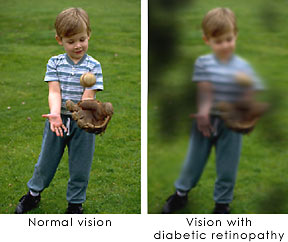Diabetic Eye Problems

Diabetes affects the eye in a number of ways. The most damaging condition occurs when the fine network of blood vessels in the retina – the light-sensitive inner lining of the back of the eye – leak fluid. This is known as diabetic retinopathy. Cataracts also develop earlier and progress more rapidly in people with diabetes than in other people. Untreated diabetes may also make cause frequent or noticeable changes to your eyesight.
Serious eye problems are less likely if the diabetes is well controlled or in its early stages. Most sight loss from diabetic eye disease can be prevented if detected early and treated.
How can your optometrist help?
Optometrists have an important role to play in detecting the disease and in monitoring the eyes of people with diabetes once diagnosed. Checking the appearance of the retina with an ophthalmoscope, a special torch for looking into the eyes, is the most commonly used test for diabetic eye problems. Photographs of the retina may also be used to detect and monitor any abnormalities.
Remember, however, that if your vision is getting worse, this does not necessarily mean you have diabetic retinopathy. It may simply be a problem that can be corrected with spectacles.
